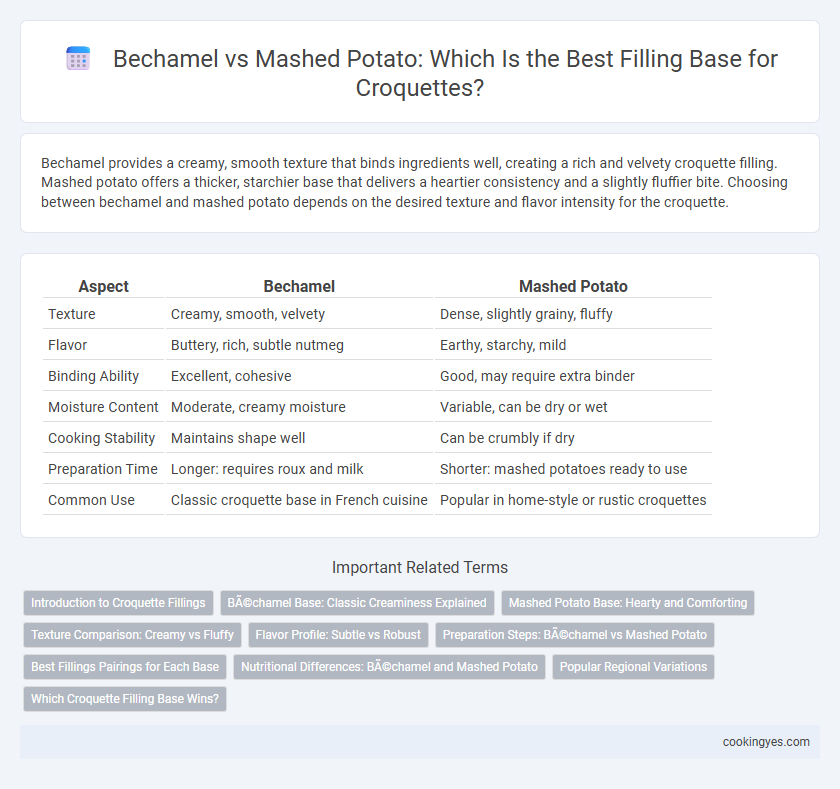Bechamel provides a creamy, smooth texture that binds ingredients well, creating a rich and velvety croquette filling. Mashed potato offers a thicker, starchier base that delivers a heartier consistency and a slightly fluffier bite. Choosing between bechamel and mashed potato depends on the desired texture and flavor intensity for the croquette.
Table of Comparison
| Aspect | Bechamel | Mashed Potato |
|---|---|---|
| Texture | Creamy, smooth, velvety | Dense, slightly grainy, fluffy |
| Flavor | Buttery, rich, subtle nutmeg | Earthy, starchy, mild |
| Binding Ability | Excellent, cohesive | Good, may require extra binder |
| Moisture Content | Moderate, creamy moisture | Variable, can be dry or wet |
| Cooking Stability | Maintains shape well | Can be crumbly if dry |
| Preparation Time | Longer: requires roux and milk | Shorter: mashed potatoes ready to use |
| Common Use | Classic croquette base in French cuisine | Popular in home-style or rustic croquettes |
Introduction to Croquette Fillings
Croquette fillings commonly use bechamel or mashed potato as bases, each offering distinct textures and flavors. Bechamel provides a creamy, smooth consistency that enhances the richness of meat or seafood fillings, while mashed potatoes deliver a denser, more rustic texture ideal for vegetable or cheese croquettes. Selecting the right base affects the croquette's mouthfeel and overall taste, making it essential to match the filling with the base for optimal culinary results.
Béchamel Base: Classic Creaminess Explained
Bechamel base offers a smooth, creamy texture essential for classic croquettes, achieved by blending butter, flour, and milk into a rich sauce that holds fillings together without heaviness. This traditional French white sauce provides a delicate balance, enhancing flavors while maintaining a firm yet tender interior that crisps perfectly when fried. Compared to mashed potato, bechamel yields a silkier mouthfeel and more refined consistency, making it the preferred choice for authentic, elegant croquettes.
Mashed Potato Base: Hearty and Comforting
Mashed potato base offers a hearty and comforting texture for croquettes, providing a creamy yet dense filling that holds shape well during frying. Rich in natural starches, mashed potatoes deliver a satisfying bite that contrasts perfectly with crispy, golden exteriors. This filling style enhances the croquette's rustic appeal, making it a popular choice in traditional and modern recipes alike.
Texture Comparison: Creamy vs Fluffy
Bechamel-based croquettes offer a creamy, smooth texture that binds fillings seamlessly, creating a rich mouthfeel ideal for delicate flavor combinations. Mashed potato fillings provide a fluffy, airy consistency with slight graininess, adding a light bite and subtle starchiness that contrasts with crispy exteriors. The choice impacts the overall croquette experience, balancing creaminess against fluffiness to suit different culinary preferences.
Flavor Profile: Subtle vs Robust
Bechamel-based croquettes offer a creamy, delicate flavor profile with a smooth, velvety texture that enhances subtle ingredients like herbs or seafood. Mashed potato fillings provide a robust, earthy taste with a denser texture, intensifying the savory impact of stronger fillings such as meat or cheese. Choosing between Bechamel and mashed potato bases directly influences the overall taste experience, balancing subtle elegance against hearty richness.
Preparation Steps: Béchamel vs Mashed Potato
Bechamel-based croquettes require creating a roux with butter and flour, then slowly incorporating milk to form a thick, creamy sauce that serves as a smooth filling base, often cooled and chilled before shaping. Mashed potato croquettes start by boiling and mashing potatoes, blending them with seasonings and sometimes cheese or butter to achieve a fluffy, textured filling, which is then shaped and fried. The bechamel method emphasizes precise cooking to achieve the right consistency, while mashed potato preparation focuses on achieving the ideal moisture level to prevent the croquettes from being too dry or too loose.
Best Fillings Pairings for Each Base
Bechamel-based croquettes deliver a creamy, smooth texture that pairs exceptionally well with finely chopped ham, sauteed mushrooms, and melted cheese, enhancing the richness of each bite. Mashed potato fillings offer a hearty, rustic foundation perfect for incorporating robust ingredients like crispy bacon, caramelized onions, and sharp cheddar, which complement the denser consistency. Choosing the right filling based on the base texture ensures optimal flavor balance and mouthfeel in every croquette.
Nutritional Differences: Béchamel and Mashed Potato
Bechamel-based croquettes typically contain more calories and fats due to the butter and milk in the sauce, providing a richer texture and creaminess. Mashed potato croquettes offer higher fiber content and complex carbohydrates, contributing to longer-lasting energy and a lower fat profile. Both bases supply essential nutrients such as calcium from bechamel and potassium from mashed potatoes, influencing overall nutritional value depending on dietary goals.
Popular Regional Variations
Bechamel-based croquettes are favored in European cuisines like Spanish and French regions, offering a creamy, smooth texture that binds ingredients effectively. In contrast, mashed potato fillings dominate in parts of North America and the Caribbean, providing a denser, heartier consistency often enriched with local spices. Popular regional variations highlight bechamel croquettes filled with ham or cheese, while mashed potato croquettes frequently incorporate meats or vegetables for robust flavor.
Which Croquette Filling Base Wins?
Bechamel provides a creamy, smooth texture that binds ingredients effectively, creating a rich and velvety croquette filling, while mashed potatoes offer a denser, heartier base with a more rustic flavor and firmer bite. Culinary experts favor bechamel for upscale croquettes due to its silky mouthfeel and versatility in blending with various flavors, whereas mashed potato croquettes excel in comfort food settings, delivering a satisfying, starchy consistency. Nutritionally, mashed potato bases tend to be higher in fiber and vitamins, whereas bechamel fillings are richer in calories and fats, influencing the final choice based on dietary preferences.
Béchamel vs Mashed Potato for croquette filling base Infographic

 cookingyes.com
cookingyes.com